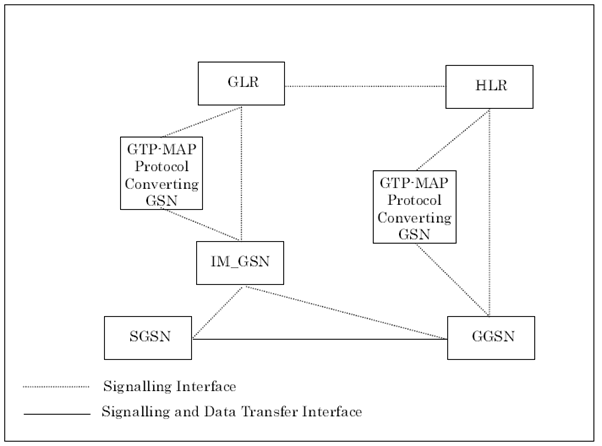Content for TS 29.119 Word version: 18.0.0
1 Scope
1.1 References
2 Definitions and abbreviations
2.1 Definitions
2.2 Abbreviations
3 General
...
...
1 Scope p. 5
The present document describes the signalling requirements and procedures used at network elements related to the GLR for GTP within the 3GPP system at the application level.
The present document gives the description of the systems needed only in the network utilising GLR as the delta document against TS 29.060.
1.1 References p. 5
The following documents contain provisions which, through reference in this text, constitute provisions of the present document.
- References are either specific (identified by date of publication, edition number, version number, etc.) or non-specific.
- For a specific reference, subsequent revisions do not apply.
- For a non-specific reference, the latest version applies. In the case of a reference to a 3GPP document (including a GSM document), a non-specific reference implicitly refers to the latest version of that document in the same Release as the present document.
[1]
TS 23.060: "General Packet Radio Service (GPRS); Service description Stage2".
[2]
TS 23.119: "Gateway Location Register (GLR) - stage2".
[3]
TS 24.008: "Mobile radio interface layer 3 specification, Core Network Protocols - Stage 3".
[4]
TS 29.002: "Mobile Application Part (MAP) specification".
[5]
TS 29.060: "General Packet Radio Service (GPRS); GPRS Tunnelling Protocol (GTP) across the Gn and Gp Interface".
2 Definitions and abbreviations p. 5
2.1 Definitions p. 5
For the purposes of the present document, the following terms and definitions apply.
Gateway Location Register:
this entity handles location management of roaming subscriber in visited network without involving HLR
Intermediate GSN:
this entity is used as serving GSN towards home network and relay some PDU notification messages between serving GSN and Gateway GSN
MM context:
information sets held in MS and GSNs for a GPRS subscriber related to mobility management (MM)
MM Context ID:
IMSI or equivalent for use in conjunction with Anonymous Access (please refer to section GTP Header)
Path:
UDP/IP path and TCP/IP path are examples of paths that may be used to multiplex GTP tunnels
Path Protocol:
path Protocol is the protocol(s) used as a bearer of GTP between GSNs
PDP:
packet Data Protocol (PDP) is a network protocol used by an external packet data network interfacing to GPRS
PDP Context:
information sets held in MS and GSNs for a PDP address
Signalling message:
GTP signalling messages are exchanged between GSN pairs in a path. The signalling messages are used to transfer GSN capability information between GSN pairs and to create, update and delete GTP tunnels
T-PDU:
original packet, for example an IP datagram, from an MS or a network node in an external packet data network. A T-PDU is the payload that is tunnelled in the GTP tunnel
Tunnel Endpoint Identifier (TEID):
this field unambiguously identifies a tunnel endpoint in the receiving GTP-U or GTP-C protocol entity. The receiving end side of a GTP tunnel locally assigns the TEID value the transmitting side has to use. The TEID values are exchanged between tunnel endpoints using GTP-C messages
2.2 Abbreviations p. 6
For the purposes of the present document, the following abbreviations apply:
GGSN
Gateway GPRS support node
GLR
Gateway Location Register
GPRS
General Packet Radio Service
GTP
GPRS Tunnelling Protocol
IM_GSN
Intermediate GSN
IP
Internet Protocol
GLR
Gateway Location Register
SGSN
Serving GPRS support node
TEID
Tunnel Endpoint IDentifier
UDP
User Datagram Protocol
3 General p. 6
The present document defines the GPRS Tunnelling Protocol (GTP) specific to the network with the GLR, i.e. the protocol between IM_GSN and other nodes (i.e. GGSN, SGSN and GTP-MAP protocol converting GSN). It includes only the GTP signalling but not data transfer procedures.
The interface between IM_GSM and GGSN is either intra-PLMN interface or inter-PLMN interface.

Figure 1: Logical Architecture for PS domain in the network with GLR
(⇒ copy of original 3GPP image)
(⇒ copy of original 3GPP image)
The GTP protocol is implemented only by IM_GSNs, SGSNs and GGSNs. No other systems need to be aware of GTP. GPRS MSs are connected to a SGSN without being aware of GTP.
It is assumed that there will be a many-to-many relationship between IM_GSNs, SGSNs and GGSNs. An IM_GSN may provide service to many GGSNs. A SGSN may provide service to many IM_GSNs and GGSNs.